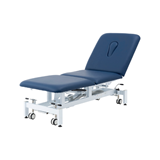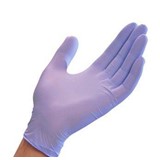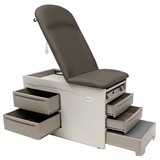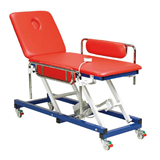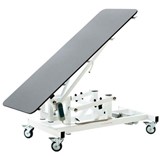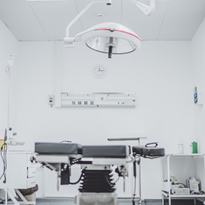Examination tables are essential medical equipment used in various healthcare settings, facilitating patient examinations and diagnostics. To maintain their optimal functionality and ensure patient well-being, it is crucial to implement routine maintenance and safety practices. This informative and professional guide aims to provide valuable insights and expert recommendations for healthcare practitioners and facility managers to uphold the highest standards in examination table care.
suitable lubricants and calibration tools
1. Developing a Routine Maintenance Plan for Examination Tables
A. Understanding the Components of an Examination Table
- Explaining the anatomy of modern examination tables
- Identifying key mechanical, electrical, and upholstered parts
- Describing the interplay between components for seamless functionality
B. Establishing a Maintenance Schedule
- Outlining the benefits of a structured maintenance plan
- Suggesting a recommended maintenance frequency based on usage and manufacturer guidelines
- Tailoring maintenance schedules for high-traffic versus low-traffic facilities
C. Regular Cleaning and Upkeep Procedures
- Presenting the importance of cleanliness and hygiene in healthcare settings
- Detailing cleaning protocols for different examination table surfaces (e.g., vinyl, leather, stainless steel)
- Addressing proper disposal of contaminated materials
D. Lubrication and Calibration for Mechanical Components
- Stressing the role of lubrication in preventing friction-related issues
- Demonstrating the calibration process for electronic and hydraulic features
- Recommending suitable lubricants and calibration tools
Cleaning and Disinfection Procedures to Maintain Hygiene Standards
A. Choosing Appropriate Cleaning Agents and Disinfectants
- Explanation of the importance of using suitable cleaning agents
- Recommended types of cleaning agents for different table materials
- Considerations for eco-friendly and patient-safe options
B. Step-by-step Cleaning Process for Different Table Materials
- Cleaning procedures for upholstery, ensuring hygiene and durability
- Cleaning methods for metal parts to prevent corrosion and maintain appearance
- Specific cleaning requirements for other materials used in examination tables
C. Disinfection Protocols to Prevent Cross-contamination
- Understanding the difference between cleaning and disinfection
- Importance of targeted disinfection to eliminate pathogens effectively
- Step-by-step guide for disinfecting examination table surfaces
D. Recommended Frequency for Cleaning and Disinfection
- Factors influencing the frequency of cleaning and disinfection
- Tailoring the schedule based on patient volume and types of examinations
- Adhering to industry standards and guidelines for best practices
2. Inspecting and Maintaining Examination Table Components
Proper maintenance of examination tables is essential to ensure their longevity and the well-being of patients. Regular inspection and care of various components contribute to the overall safety and functionality of the table. This section will provide comprehensive guidelines on how to inspect and maintain examination table components, covering upholstery care, electrical and mechanical part functionality, replacement considerations, and the importance of periodic professional inspections and servicing.
A. Upholstery Inspection and Care
- Examination: Regularly inspect the upholstery for signs of wear, tear, or damage.
- Tears and Rips: Immediately address any tears or rips to prevent further damage and maintain patient comfort.
- Cleaning: Follow manufacturer-approved cleaning procedures for the upholstery material.
- Disinfection: If applicable, use appropriate disinfectants on upholstery surfaces to maintain hygiene standards without causing harm to the material.
- Protective Covers: Consider using disposable or washable protective covers to enhance the longevity of the upholstery.
B. Ensuring Proper Functionality of Electrical and Mechanical Parts
- Functional Testing: Periodically test all electrical and mechanical components of the examination table for proper functioning.
- Height Adjustment: Verify that the height adjustment mechanism works smoothly and securely locks in place.
- Backrest and Leg Rest: Ensure smooth operation of the backrest and leg rest mechanisms.
- Power Cords: Check power cords for any signs of damage, and replace if necessary to prevent electrical hazards.
- Stability: Assess the table's stability to avoid any wobbling or imbalance during examinations.
C. Replacement Guidelines for Damaged Components
- Manufacturer Guidelines: Always refer to the manufacturer's guidelines for replacing damaged components.
- Original Parts: Use genuine replacement parts provided by the manufacturer to maintain the table's integrity.
- Professional Assistance: Seek professional help to replace intricate components that require specialized knowledge or tools.
- Calibration: After replacement, ensure proper calibration of electrical and mechanical parts to ensure accurate functioning.
D. Periodic Professional Inspections and Servicing
- Schedule: Establish a schedule for periodic professional inspections and servicing of the examination table.
- Expert Technicians: Engage qualified and experienced technicians to conduct inspections and servicing.
- Thorough Evaluation: Ensure that the inspection covers all aspects of the table's safety and functionality.
- Servicing: Regular servicing will address general wear and tear, contributing to the table's optimal performance.
- Record Keeping: Maintain detailed records of inspections and servicing for reference and warranty purposes.
3. Implementing Safety Protocols for Patient Transfer and Positioning
A. Ensuring Safe Patient Transfers onto the Examination Table
- Preparing the examination room for patient arrival
- Communicating with the patient and addressing concerns
- Assisting patients with mobility challenges during transfer
B. Proper Positioning to Avoid Discomfort and Injuries
- Understanding the significance of proper positioning
- Aligning the patient for various examination types
- Considering ergonomic factors for both patient and healthcare provider
- Utilizing adjustable features of the examination table
C. Using Assistive Devices When Needed
- Identifying patients who require assistive devices
- Providing appropriate assistive devices for specific needs
- Educating patients and staff on the proper use of assistive devices
- Regularly inspecting and maintaining assistive devices for safety
D. Staff Training on Safe Handling Techniques
- Comprehensive training on patient transfer and positioning
- Demonstrating correct lifting and transferring methods
- Educating staff on potential risks and how to mitigate them
- Regular drills and practice sessions for emergency situations
4. Ensuring Adequate Patient Support and Comfort during Examinations
Patient support and comfort are vital aspects of providing effective healthcare services. Ensuring that patients feel at ease during examinations not only enhances their overall experience but also plays a significant role in obtaining accurate diagnoses. In this section, we will explore the various measures healthcare facilities can take to ensure adequate patient support and comfort during examinations.
A. Importance of Patient Comfort for Accurate Diagnosis
- Discuss the correlation between patient comfort and the reliability of examination results.
- Explain how relaxed patients are more likely to cooperate and experience less anxiety, leading to better outcomes.
- Emphasize the role of a comfortable examination table in facilitating patient relaxation.
B. Utilizing Adjustable Features for Patient Convenience
- Highlight the benefits of examination tables equipped with adjustable features.
- Discuss how adjustable height, backrest, and leg rest contribute to patient comfort and convenience.
- Provide examples of scenarios where these features prove to be particularly useful.
C. Providing Additional Cushions and Supports as Required
- Explain the significance of providing supplementary cushions and supports during examinations.
- Discuss specific medical conditions or patient groups that may require extra support.
- Provide guidelines for selecting appropriate cushions and supports based on individual needs.
D. Addressing Specific Patient Needs and Considerations
- Discuss the importance of tailoring examination table arrangements to meet individual patient requirements.
- Address considerations for pediatric patients, elderly patients, and patients with disabilities.
- Provide insights into ensuring a safe and comfortable experience for pregnant patients.
5. Training Staff for Proper Usage and Safe Practices with Examination Tables
A. Comprehensive training on examination table operation
- Importance of thorough training for medical staff
- Understanding the different types of examination tables and their features
- Familiarization with control mechanisms and adjustments
- Safety precautions while operating the table
B. Demonstrating correct usage of specialized features
- Training on adjustable positions and settings
- Proper usage of patient support accessories (e.g., stirrups, armrests)
- Demonstrating weight capacity limitations and safe patient transfer techniques
- Highlighting potential risks associated with improper usage
C. Educating staff about safety protocols and infection control measures
- Importance of maintaining a hygienic environment
- Step-by-step guidelines for cleaning and disinfection
- Proper disposal of contaminated materials and waste
D. Regular refresher training to keep staff updated
- Establishing a schedule for ongoing training sessions
- Incorporating updates on new safety guidelines and protocols
- Addressing common mistakes and areas of improvement
- Encouraging continuous learning and improvement among staff
6. Addressing Infection Control Measures for Examination Table Surfaces
A. Understanding the Risk of Surface Contamination
- Sources of potential contamination
- Transmission of pathogens through contaminated surfaces
- Impact on patient safety and health outcomes
B. Proper Cleaning and Disinfection Techniques for Infection Prevention
- Importance of regular cleaning and disinfection
- Choosing appropriate cleaning agents and disinfectants
- Step-by-step cleaning process
A Pre-cleaning preparation
- Cleaning methods for different table materials (e.g., upholstery, metal)
- Disinfection procedures for high-touch areas
- Drying and finishing steps
- Disposable paper covers
- Plastic coverings and wraps
- Ensuring full coverage and protection
- Disposal and replacement guidelines
- Collaborating with healthcare professionals and infection control experts
- Incorporating examination table maintenance into the plan
- Ensuring understanding of proper cleaning and disinfection protocols
- Reinforcing the importance of adherence to protocols
- Monitoring and evaluating compliance with infection control standards
- Making necessary adjustments for continuous improvement
C. Disposable Barrier Options and Their Appropriate Usage
- Advantages of disposable barriers
- Types of disposable barriers available
- Proper application of disposable barriers
D. Integrating Infection Control into the Overall Facility Protocols
- Creating a comprehensive infection control plan
- Staff training and education on infection control measures
- Regular audits and quality assurance checks
In conclusion, the meticulous maintenance and safety practices detailed in this guide are integral to ensuring the longevity of examination tables and the well-being of patients. These practices encompass a comprehensive range of considerations, from routine maintenance plans and cleaning procedures to patient transfer protocols and infection control measures.
Developing a structured maintenance schedule, understanding the anatomy of examination tables, and implementing proper cleaning and disinfection techniques are paramount to maintaining hygiene and preventing cross-contamination. Regular inspection and maintenance of upholstery, mechanical components, and electrical systems contribute to the overall safety and functionality of the tables. The replacement of damaged components using manufacturer-approved parts and periodic professional inspections further enhance their performance and lifespan.




